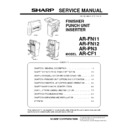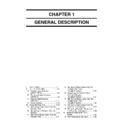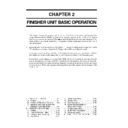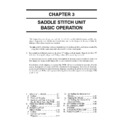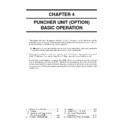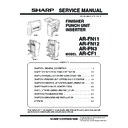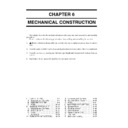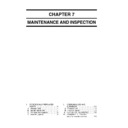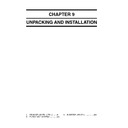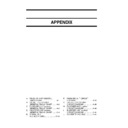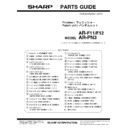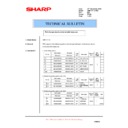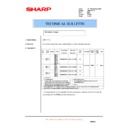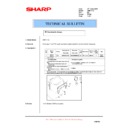Sharp AR-F11 Service Manual / Specification ▷ View online
General Precautions for Installation/Servicing/Maintenance for the Finisher
AR-FN11/FN12, Hole punch unit AR-PN3, Inserter AR-CF1
The installation and service should be done by a qualified service technician.
1. When installing the Finisher AR-FN11/FN12, Hole punch unit AR-PN3, Inserter AR-
1. When installing the Finisher AR-FN11/FN12, Hole punch unit AR-PN3, Inserter AR-
CF1 to the Plain Paper Copier, be sure to follow the instructions described in the “Un-
packing/Set-Up Procedure for the AR-FN11/FN12/AR-PN3/AR-CF1” booklet which
comes with each unit of the AR-FN11/FN12/AR-PN3/AR-CF1.
packing/Set-Up Procedure for the AR-FN11/FN12/AR-PN3/AR-CF1” booklet which
comes with each unit of the AR-FN11/FN12/AR-PN3/AR-CF1.
2. The AR-FN11/FN12, AR-PN3, AR-CF1 should be installed by an authorized/qualified
person.
3. Before starting installation, servicing or maintenance work, be sure to turn off and un-
plug the copier first.
4. When selecting the installation site, avoid placing the AR-FN11/FN12/AR-CF1 and
copier on different levels or inclined floors.
5. When servicing or maintaining the AR-FN11/FN12/AR-PN3/AR-CF1, be careful about
the rotating or operation sections such as gears, pulleys, sprockets, cams, belts, etc.
6. When parts are disassembled, reassembly is the reverse of disassembly unless other-
wise noted in this manual or other related materials. Be careful not to reassemble small
parts such as screws, washers, pins, E-rings, toothed washers to the wrong places.
parts such as screws, washers, pins, E-rings, toothed washers to the wrong places.
7. Basically, the machine should not be operated with any parts removed or disassembled.
8. Delicate parts for preventing safety hazard problems (such as breakers, thermofuses,
8. Delicate parts for preventing safety hazard problems (such as breakers, thermofuses,
fuses, door switches, sensors, etc. if any) should be handled/installed/adjusted cor-
rectly.
rectly.
9. Use suitable measuring instruments and tools.
10. During servicing or maintenance work, be sure to check the serial No. plate and other
10. During servicing or maintenance work, be sure to check the serial No. plate and other
cautionary labels (if any) to see if they are clean and firmly fixed. If not, take appropriate
actions.
actions.
11. The PC board must be stored in an anti-electrostatic bag and handled carefully using
a wristband, because the ICs on it may be damaged due to static electricity. Before
using the wrist band, pull out the power cord plug of the copier and make sure that
there is no uninsulated charged objects in the vicinity.
using the wrist band, pull out the power cord plug of the copier and make sure that
there is no uninsulated charged objects in the vicinity.
12. For the recovery and disposal of used AR-FN11/FN12/AR-PN3/AR-CF1s, consum-
able parts, packing materials, used batteries, and RAM-ICs including lithium batteries,
it is recommended that the relevant local regulations/rules.
it is recommended that the relevant local regulations/rules.
13. After completing installation, servicing and maintenance of the AR-FN11/FN12/AR-
PN3/AR-CF1, return the AR-FN11/FN12/AR-PN3/AR-CF1 to its original state, and
check operation.
check operation.
[A]
[B]
14. When you move the finisher, do not move it in the direction of the arrow as shown in the
figure [A] below otherwise it might fall down. Also, when installing the inserter AR-CF1,
hold it as the figure [B] below shows in order for your hands not to be caught.
hold it as the figure [B] below shows in order for your hands not to be caught.
Copyright © 2002
SHARP Corporation
i
INTRODUCTION
This Service Manual contains basic data and figures for the Finisher (AR-F11)/Saddle
Finisher (AR-F12) needed to service the machine in the field.
This manual comprises the following chapters:
Chapter 1
“General Description” introduces the finisher’s features, specifications, and
names of parts, and shows how to operate the finisher.
Chapter 2
“Finisher Unit Basic Operation” discusses the principles of operation used for
the finisher mechanical and electrical systems. It also explains the timing at
which these systems are operated.
which these systems are operated.
Chapter 3
“Saddle Finisher Unit Basic Operation” discusses the principles of operation
used for the saddle stitch unit’s mechanical and electrical systems. It also
explains the timing at which these systems are operated.
used for the saddle stitch unit’s mechanical and electrical systems. It also
explains the timing at which these systems are operated.
Chapter 4
“Puncher (option) Unit Basic Operation” discusses the principles of operation
used for the puncher unit’s mechanical and electrical systems. It also explains
the timing at which these systems are operated.
the timing at which these systems are operated.
Chapter 5
“Inserter (option) Unit Basic Operation” discusses the principles of operation
used for the inserter units mechanical and electrical systems. It also explains
the timing at which these systems are operated.
used for the inserter units mechanical and electrical systems. It also explains
the timing at which these systems are operated.
Chapter 6
“Mechanical System” discusses how the finisher is constructed mechanically,
and shows how it may be disassembled/assembled and adjusted.
Chapter 7
“Maintenance and Inspection” provides tables of periodically replaced parts
and consumables and durables, together with a scheduled servicing chart.
Chapter 8
“Troubleshooting” shows how to troubleshoot possible faults and gives electri-
cal parts arrangement diagrams, LED/check pin diagrams by PCB, and self
diagnosis tables.
diagnosis tables.
“Appendix” contains diagrams showing tables of signals, overall circuit dia-
grams and tables of solvents/oils.
grams and tables of solvents/oils.
Descriptions regarding installation are not mentioned in this Service Manual as the
Finisher (AR-F11)/Saddle Finisher (AR-F12)’s packing boxes contain Installation Proce-
dures.
dures.
The descriptions in this Service Manual are subject to change without notice for prod-
uct improvement or other purposes, and major changes will be communicated in the form
of Service Information bulletins.
of Service Information bulletins.
All service persons are expected to have a good understanding of the contents of this
Service Manual and all relevant Service Information bulletins, and be able to identify and
isolate faults in the machine.
isolate faults in the machine.

